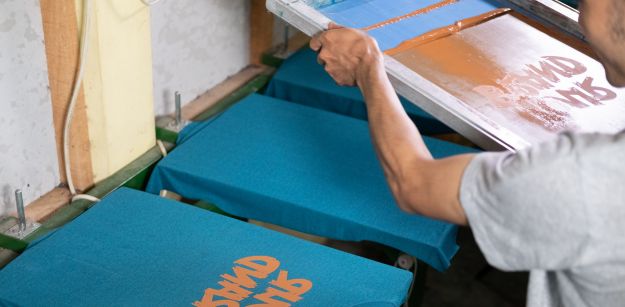T-shirt printing has come a long way since its inception, evolving from simple hand-painted designs to a variety of sophisticated techniques that allow for intricate and detailed prints. Today, T-shirt printing is a popular method for creating personalized and customized apparel for both individuals and businesses. In this blog, we will explore some of the most popular T-shirt printing techniques, from traditional screen printing to modern direct-to-garment printing.


1. Screen Printing
One of the most traditional and widely used methods for printing T-shirts is screen printing. It entails making a stencil, sometimes known as a screen, and applying layers of ink to the T-shirt surface using it. To create the final design, each color is applied one at a time using a different stencil.
The first step in the process is to create a design and divide it into several hues. After that, each hue is printed onto a film, which serves as the stencil’s creation. After positioning the stencil on a screen, ink is put to the screen and forced through the stencil to reveal the T-shirt underneath. After that, the T-shirt is dried, and each color is done in turn.
Printing a lot of T-shirts with the same design in bulk can be done economically with screen printing. However, as each color needs its own screen and stencil, it is not appropriate for small orders or designs with a lot of colors.
2. Heat Transfer Printing
Heat transfer printing is another popular T-shirt printing technique. It involves printing a design onto a special paper and then transferring it onto the T-shirt using heat and pressure. The design is first printed onto the transfer paper using an inkjet or laser printer. The paper is then placed on the T-shirt, and heat and pressure are applied to transfer the design onto the fabric.
For modest orders, heat transfer printing is a flexible approach that can produce full-color prints. The T-shirt may feel stiff where the pattern is applied, and the prints might not be as long-lasting as those created using alternative techniques.
3. Direct-to-Garment Printing
Direct-to-garment (DTG) printing is a modern T-shirt printing technique that uses specialized inkjet printers to print designs directly onto the fabric. The process begins with creating a digital design and then printing it onto the T-shirt using a DTG printer. The T-shirt is then dried and cured to set the ink.
DTG printing is an adaptable technique that can produce detailed drawings and full-color prints. It can create excellent prints that are long-lasting and delicate to the touch, and it is appropriate for small orders. It may not be cost-effective for large orders, though, as it is more expensive than other approaches.
4. Sublimation Printing
Sublimation printing is a technique that uses heat to transfer dye onto the fabric. The design is first printed onto a special paper using sublimation ink. The paper is then placed on the T-shirt, and heat and pressure are applied to transfer the dye onto the fabric. The dye turns into gas and penetrates the fabric, creating a vibrant and durable print.
Full-color prints may be produced using sublimation printing, which also yields lasting, high-quality prints that are pleasant to the touch. It might not be economical for modest orders, though, as it is only appropriate for polyester textiles.
5. Vinyl Cutting
Vinyl cutting is a technique that involves cutting designs out of colored vinyl and then heat-pressing them onto the T-shirt. The design is first created and then cut out of the vinyl using a cutting machine. The vinyl is then placed on the T-shirt, and heat and pressure are applied to transfer the design onto the fabric.
Vinyl cutting is a versatile method that allows for intricate designs and is suitable for small orders. However, the prints may not be as durable as other methods, and the T-shirt may feel stiff where the design is applied.
6. Screen Printing
The potential of screen printing to create vivid and durable prints is well known. Given that each hue needs its own screen, this approach works best for designs with a limited palette. Because screen printing uses thicker ink than other techniques, the print is resistant to fading even after multiple washings. However, screen printing may be time-consuming and expensive to set up, so it’s not as good for small orders or multicolored designs.
7. Heat Transfer Printing
Heat transfer printing is a versatile method that allows for full-color prints with a high level of detail. This method is suitable for small orders and can be used on a variety of fabrics. However, the prints may crack or fade over time, and the T-shirt may feel stiff where the design is applied. Additionally, the colors may not be as vibrant as other methods, and the print may not withstand numerous washes.
8. Direct-to-Garment Printing
The innovative method known as direct-to-garment (DTG) printing produces prints that are delicate to the touch and of excellent quality. This technique works well for full-color prints and complex graphics. DTG printing produces prints that are durable and soft to the touch because the ink is water-based and absorbs into the cloth. DTG printing is more expensive than other techniques, hence it could not be economical for big orders.
9. Sublimation Printing
A special method that produces vivid and durable prints is sublimation printing. Full-color prints may be produced with this technique, which also yields durable, high-quality images that are pleasant to the touch. Sublimation printing, however, works best with polyester materials and might not be affordable for smaller quantities.
10. Vinyl Cutting
Vinyl cutting is a versatile method that allows for intricate designs and is suitable for small orders. The vinyl used in this method is durable and can withstand numerous washes without fading. However, the prints may feel stiff, and the colors may not be as vibrant as other methods.
In Conclusion
There are benefits and drawbacks specific to each T-shirt printing method. A number of criteria, such as the design, quantity, fabric, and budget, influence the process selected. Whatever technique is used, T-shirt printing is an amazing way to showcase creativity and produce distinctive, unique, and customized clothing. You can select the T-shirt printing method that best meets your demands by being aware of the various approaches available.



